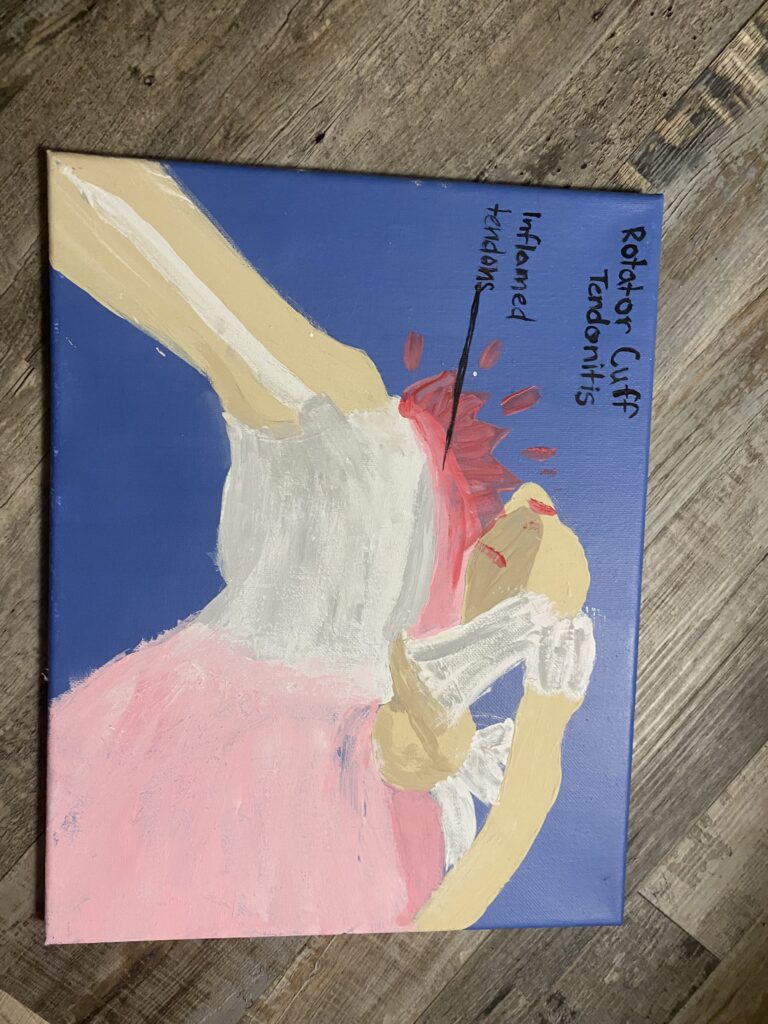Topic: Rotator Cuff Tendinitis
Objective: Relate the interaction of muscles and the skeletal system
Rotator cuff tendinitis is very common in athletes who exert the muscles in their shoulders continuously, like tennis, volleyball, swimming, heavy lifting, gymnastics, etc. The tendonitis is due to the injury of the tendons, although this is fairly common, it is hard to diagnose because there is very little evidence of inflammation. People who have rotator cuff tendinitis may experience extreme pain in the shoulder from doing simple everyday tasks. It may become aggravated from lifting the arm too high as to put on a shirt or brushing hair, even sleeping may become difficult from the pressure put on the inflamed tendons. Pain may also be experienced from pushing, pulling, or lifting.
The rotator cuff is composed of four muscles each accompanied by their own tendons which attaches to the upper arm bone called the humerus. The Supraspinatus, Infraspinatus, Teres minor, and Subscapularis are the tendons of the muscles of the shoulder, which form a cuff at the head of the humerus. These tendons work together with the muscles to stabilize and control the humerus head as you move your arm, creating the ball and socket formation (Simmon and Roberts). The most vulnerable of these tendons is the Supraspinatus, which is imperative for the upward movement of the arm. When these tendons are inflamed due to rotator cuff tendinitis, it may weaken the muscles surrounding the shoulder and could eventually cause long term effects.
When left untreated rotator cuff tendinitis eventually causes the blood supply to the tendons to degenerate. This causes a decrease in tensile strength (resistance to breaking under tension) which can harm the attached muscles and weaken them in the process. Degenerative changes to the shoulder and tendons are located at the head of the humerus where each tendon attaches. The lack of blood supply and the degeneration can cause focal cell death (death of cell due to injury or disease) within the tendons. If this happens, the person may have much more decreased movement abilities, where the joint is used less, creating a “frozen shoulder”, where it is almost impossible to move the arm in any way.
When the tendons of the rotator cuff are damaged, they swell and become irritated and inflamed and when this happens, movement of the arm is restricted and painful. When trying to treat the injury, assisting with this is the main priority. Patients may use ice or heat, take antiinflammatory medicines or pain medicines, and physical therapy to strengthen the muscles surrounding the tendons. It is the hope that these treatments are successful, but if not, surgery may be necessary to compensate for the pain.
My painting depicts the shoulder, it’s muscles and bones. The brown/tan color is used to depict the bones inside the shoulder, the large pink area at the bottom right is the muscles, and the white is the other tendons involved in the shoulder. The highlighted pink area with the red “flames” coming off is to show the inflamed tendon. I chose to only color the specific tendon at the outer edge of the shoulder because it is the tendon most affected by rotator cuff tendinitis.

Citations
Armstrong, April D. “Shoulder Impingement/Rotator Cuff Tendinitis – Orthoinfo – Aaos.” OrthoInfo, July 2021, orthoinfo.aaos.org/en/diseases–conditions/shoulder-impingementrotator-cuff-tendinitis/.
Macnab, I. “Rotator Cuff Tendinitis.” Annals of the Royal College of Surgeons of England, Royal College of Surgeons of England, Nov. 1973, www.ncbi.nlm.nih.gov/pmc/articles/PMC2388336/.
Simmons, Stephen M, and Michael Robberts . “Patient Education: Rotator Cuff Tendinitis and Tear (Beyond the Basics).” UpToDate, 15 Apr. 2021, www.uptodate.com/contents/rotator-cuff-tendinitis-and-tear-beyond-the-basics.
Symonds, Gabriel, et al. “Disease Of The Rotator Cuff [with Reply].” BMJ: British Medical Journal, vol. 307, no. 6918, BMJ, 1993, pp. 1559–1559, http://www.jstor.org/stable/29722019.
The President and Fellows of Harvard College. “What to Do about Rotator Cuff Tendinitis.” Harvard Health, 22 Apr. 2021, www.health.harvard.edu/pain/what-to-do-about-rotator-cuff-tendinitis.
